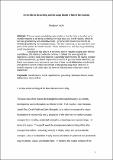Direct moral grounding and the legal model of moral normativity
Abstract
Whereas most moral philosophers believe that the facts as to what we’re morally required to do are grounded by the facts about our moral reasons, which in turn are grounded by non-normative facts, I propose that moral requirements are directly grounded by non-normative facts. This isn’t, however, to say that there is no place in the picture for moral reasons. Moral reasons exist, and they’re grounded by moral requirements. Arguing for this picture of the moral sphere requires playing both offense and defense; this article provides the defense. I defend this view against the objections (1) that it must deny that one is generally blameworthy for having violated a moral requirement, (2) that it implies the existence of genuine moral dilemmas, (3) that it runs counter to an obviously true view of how moral deliberation should work, and (4) that it cannot explain why it feels as though figuring about what one is morally required to do often takes the form of thinking about what one’s moral reasons are.
Citation
Sachs , B A 2015 , ' Direct moral grounding and the legal model of moral normativity ' , Ethical Theory and Moral Practice , vol. 18 , no. 4 , pp. 703 - 716 . https://doi.org/10.1007/s10677-015-9598-0
Publication
Ethical Theory and Moral Practice
Status
Peer reviewed
ISSN
1386-2820Type
Journal article
Description
Date of acceptance: 05/04/2015Collections
Items in the St Andrews Research Repository are protected by copyright, with all rights reserved, unless otherwise indicated.
Related items
Showing items related by title, author, creator and subject.
-
The EBLM project : II. A very hot, low-mass M dwarf in an eccentric and long-period, eclipsing binary system from the SuperWASP survey
Gómez Maqueo Chew, Y.; Morales, J.C.; Faedi, F.; García-Melendo, E.; Hebb, L.; Rodler, F.; Deshpande, R.; Mahadevan, S.; McCormac, J.; Barnes, R.; Triaud, A.H.M.J.; Lopez-Morales, M.; Skillen, I.; Collier Cameron, A.; Joner, M.D.; Laney, C.D.; Stephens, D.C.; Stassun, K.G.; Cargile, P.A.; Montañés-Rodríguez, P. (2014-12) - Journal articleIn this paper, we derive the fundamental properties of 1SWASPJ011351.29+314909.7 (J0113+31), a metal-poor (−0.40 ± 0.04 dex), eclipsing binary in an eccentric orbit (~0.3) with an orbital period of ~14.277 d. Eclipsing M ... -
Angle-resolved photoemission studies of uniaxial stress-driven Lifshitz transitions in the bulk and surface electronic structure of Sr₂RuO₄
Abarca Morales, Edgar (2023-11-29) - ThesisIn experimental condensed matter physics, the utilisation of momentum-resolved probes has proven valuable in disentangling the underpinning effects driving the formation of rich collective states in quantum materials. ... -
CALIFA : a diameter-selected sample for an integral field spectroscopy galaxy survey
Walcher, C. J.; Wisotzki, L.; Bekeraite, S.; Husemann, B.; Iglesias-Paramo, J.; Backsmann, N.; Barrera Ballesteros, J.; Catalan-Torrecilla, C.; Cortijo, C.; del Olmo, A.; Garcia Lorenzo, B.; Falcon-Barroso, J.; Jilkova, L.; Kalinova, V.; Mast, D.; Marino, R. A.; Mendez Abreu, Jairo; Pasquali, A.; Sanchez, S. F.; Trager, S.; Zibetti, S.; Aguerri, J. A. L.; Alves, J.; Bland-Hawthorn, J.; Boselli, A.; Castillo Morales, A.; Cid Fernandes, R.; Flores, H.; Galbany, L.; Gallazzi, A.; Garcia-Benito, R.; Gil de Paz, A.; Gonzalez-Delgado, R. M.; Jahnke, K.; Jungwiert, B.; Kehrig, C.; Lyubenova, M.; Marquez Perez, I.; Masegosa, J.; Ibero, A. Monreal; Perez, E.; Quirrenbach, A.; Rosales-Ortega, F. F.; Roth, M. M.; Sanchez-Blazquez, P.; Spekkens, K.; Tundo, E.; van de Ven, G.; Verheijen, M. A. W.; Vilchez, J. V.; Ziegler, B. (2014-09) - Journal articleWe describe and discuss the selection procedure and statistical properties of the galaxy sample used by the Calar Alto Legacy Integral Field Area (CALIFA) survey, a public legacy survey of 600 galaxies using integral field ...

